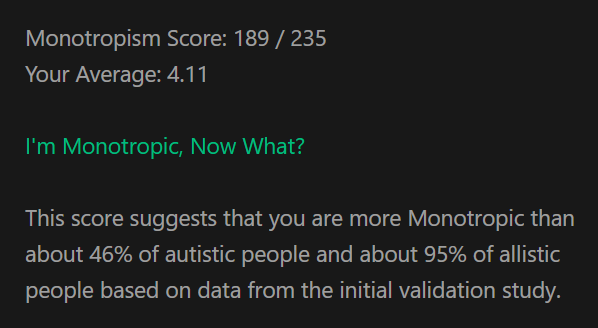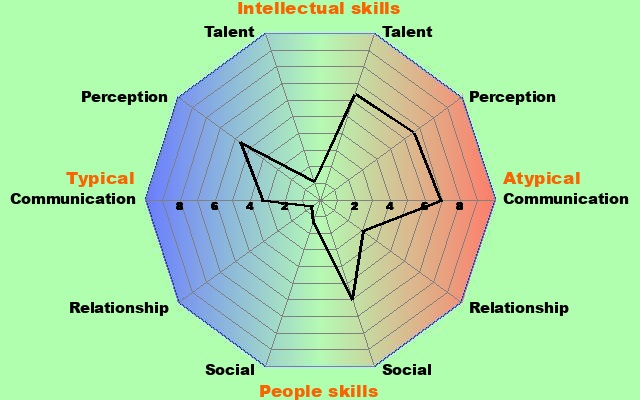This page is mostly to document my results on autism tests, maybe I will also include Other autism things I relate to.

Monotropic people usually can only focus on a few things at a time. This describes both short term and long term subjects of focus. Short term examples can include only being able to focus on the words of a conversation, having difficulty also incorperating eye contact, body language, or expressions into focus (focusing on these may mean you lose focus on the conversation). Another example is becoming engrossed in a task and having difficulty accepting new information while working on it, or switching tasks. Long term examples include special interests and only being able to work one or a few long term goals at a time. This can make decisions difficult as there is a lot of information to consider at once.
The monotropic model was developed for understanding autism, although it also applies to ADHD. Monotropism is exceedingly prevelent in autistic people, though it is not exclusive to or required for autisic people.
Starting Points for Understanding Autism - six traits of autism that the author attributes to monotropism.
Before taking this test I had never heard of monotropism and how it related to autistic people. I would say my answers are less biased because of this, thus the results more accurate.
"The AQ doesn’t really offer much insight into specific autistic traits, as it only outputs a single score. Any scores of 26 or greater indicate the presence of autistic traits; the higher the score, the more autistic traits you have. Furthermore, 79.3% of autistic people score 32 or higher (whereas only 2% of controls do), so scores of 32 and above are particularly significant. The AQ is particularly sensitive in distinguishing between autistic and non-autistic adult females, as 92.3% of autistic females scored 32 or higher (compared to 1% of the control group)."
My score was a 36.
I was very careful not to over represent my responses, maybe underrepresenting myself, so I think my score would be just a few points higher.
"The Ritvo Autism Asperger Diagnostic Scale–Revised (RAADS–R) is a self-report questionnaire designed to identify adult autistics who “escape diagnosis” due to a subclinical level presentation."
| Score | Interpretation |
|---|---|
| 25 | You are not autistic. |
| 50 | Some autistic traits, but likely not autistic (yet some autistic people score as low as 44). |
| 65 | The minimum score at which autism is considered. |
| 90 | Stronger indications of autism, although non-autistics may score as high. |
| 130 | The mean score of autistic people; strong evidence for autism. |
| 160 | Very strong evidence for autism. |
| 227 | The maximum score autistic people acquired in Ritvo’s seminal paper on the RAADS–R. |
| 240 | The maximum possible RAADS–R score. |
My score: 109 (Language: 8, Social relatedness: 43, Sensory/motor: 42, Circumscribed interests: 16)
The available answers to the questions were rather black and white, not fond of this test.
The page the the test is on describes some flaws about the test (mainly focusing on negative stereotypes like lacking compassion/sympathy), but one question in particular was very particularly bad.
"I have never wanted or needed to have what other people call an 'intimate relationship.'"
I answered yes for this one, but because I am aro ace. While autistic people are more likeley to be aspec, its harmful to perpetuate the stereotype that all are. Even the way this is phrased seems a little insulting or stereotyped.
"The goal of this test is to check atypical (autistic/neurodiverse/Aspie) and typical (neurotypical) traits in adults. Atypical traits can give a reliable indication of autism spectrum traits prior to an eventual diagnosis."

Your score: 130 of 200. 96% probability of being atypical (autistic/neurodiverse)
Each category was broken down further in a personalized PDF file!
This group contains intellectually related atypical traits. The traits are related to strong interests that can become obsessive (e.g. having strong interests; hyper focusing; collecting information; good long term memory related to interests; figuring out how things work; making connections between things). Other traits are related to information processing (e.g. noticing details; finding patterns; unusual imagination; unique ideas). Some people have special talents (e.g. numbers; language; computers; music).
A high score is related to Autism Spectrum Conditions (ASC) and Obsessive Compulsive Disorder (OCD).
Your group score: 6.4 of 10 (average)
This group contains intellectually related typical traits. These are often defined in terms of disabilities. The traits are related to verbal communication, learning by imitation, motivation, switching tasks, planning, and staying focused even when doing boring things.
A low score is related to Dyslexia and Dyscalculia, but also to other diagnoses like ADD/ADHD.
Your group score: 1.1 of 10 (below average).
This category strongly suggests I have dyslexia, dyscalculia, and/or ADHD.
This group contains atypical perception traits. These traits can become a disability by causing sensory overload and even a complete shutdown. The need for routines and predictability to a large extent seems to be caused by acute perception and the related risk of sensory overload. The core traits are hypersensitivity to touch, sound, smell, taste, strong light, humidity, wind, heat and electromagnetic fields. Some people are less sensitive to pain.
No direct, but autistic people often have differences in perception.
Your group score: 6.6 of 10 (average)
This group contains typical perception traits. The traits relate to judging time, distance, height, depth, speed, pressure & age, finding places, timing in conversations, recognizing faces & facial expressions, prosody.
A low score is related to Dyspraxia.
Your group score: 5.6 of 10 (average).
This category suggests I dont have dyspraxia.
This group contains atypical communication traits. These traits are typically called stims and include traits with a probable basis in atypical nonverbal communication (e.g. using unusual sounds in conversations; blinking or rolling eyes; clenching fists; grinding teeth; thrusting tongue; blushing) and stims with only emotional significance (e.g. wringing hands; rubbing hands; twirling fingers; rocking; tapping eyes; pressing eyes; fiddling with things; pacing; flapping hands; peeling skin flakes).
A high score relates to Autism Spectrum Conditions (ASC) where stims are regarded as repetitive movements.
Your group score: 6.9 of 10 (above average)
This category suggests I have autism based on stimming.
This group contains typical communication traits. The key trait is the ability to interpret and show typical nonverbal communication . The absence of these abilities lead to secondary problems (e.g. unaware of how to behave; unaware of boundaries; being misunderstood; missing hidden agendas; being unaware of others intentions; misinterpreting figures of speech, idioms and allegories; literal interpretation; not knowing when to apologize; saying inappropriate things; seemingly poor empathy).
A low score is related to Autism Spectrum Conditions (ASC).
Your group score: 3.3 of 10 (below average)
This category suggests I have autism based to lesser social skills.
This group contains atypical relationship and attachment traits. The main trait is a strong attachment formed at a distance through observation rather than conversation. Related to the attachment is being protective, learning routines, walking behind, and sensing presence. Some people get taken advantage of and some feel persecuted because of their preferences. Differences in eye contact is here to, with atypical people having a preference for long eye contact with people they like, which can lead to acusations of staring, and no eye contact with people they dislike in conversations.
A high score is related to "attachment disorders" and paraphilias.
Your group score: 3.0 of 10 (below average).
This category suggests I don't have any attatchment disorders.
This group contains typical relationship and attachment traits. Traits are related to the typical process of finding a partner, dating, courtship and sexual intimacy. The intimacy traits defines the norm in society and aim at creating and maintaining attachments with sex. People that dislike this norm often identify as asexual.
A low score is related to intimacy problems
Your group score: 0.6 of 10 (below average).
This category suggests I have intimacy problems. This is easily explained by the fact that I am aro ace.
This group contains atypical social traits. The traits are about putting oneself in the centre, and living in small stationary groups. It also includes having trouble with authority, arguing and revenge.
Diagnostic relation: None.
Your group score: 5.9 of 10 (average)
Not sure why this has no related diagnosis.
This group contains typical social traits. The traits are adaptations for socializing with strangers and superficial acquaintances, forming friendships and coalitions. Important traits are sharing and talking about feelings with strangers and superficial acquaintances as a way to socialize and exchange information. Hugging, waving and shaking hands are traits used in the interaction.
Diagnostic relation: None.
Your group score: 1.3 of 10 (below average)
Not sure why this doesnt have a related diagnosis either.